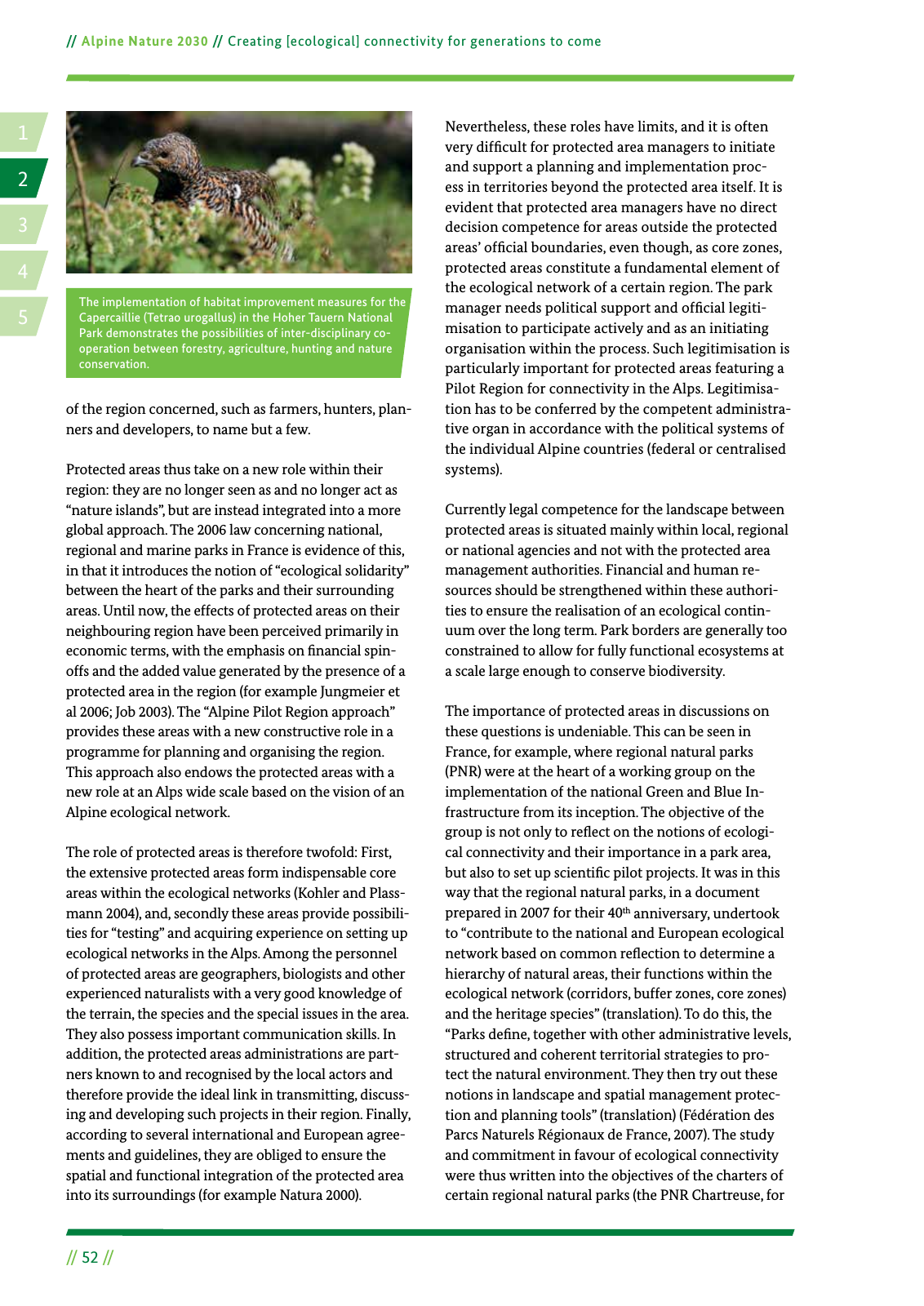14 2 5 3 52 Alpine Nature 2030 Creating ecological connectivity for generations to come The implementation of habitat improvement measures for the Capercaillie Tetrao urogallus in the Hoher Tauern National Park demonstrates the possibilities of inter disciplinary co operation between forestry agriculture hunting and nature conservation of the region concerned such as farmers hunters plan ners and developers to name but a few Protected areas thus take on a new role within their region they are no longer seen as and no longer act as nature islands but are instead integrated into a more global approach The 2006 law concerning national regional and marine parks in France is evidence of this in that it introduces the notion of ecological solidarity between the heart of the parks and their surrounding areas Until now the effects of protected areas on their neighbouring region have been perceived primarily in economic terms with the emphasis on nancial spin offs and the added value generated by the presence of a protected area in the region for example Jungmeier et al 2006 Job 2003 The Alpine Pilot Region approach provides these areas with a new constructive role in a programme for planning and organising the region This approach also endows the protected areas with a new role at an Alps wide scale based on the vision of an Alpine ecological network The role of protected areas is therefore twofold First the extensive protected areas form indispensable core areas within the ecological networks Kohler and Plass mann 2004 and secondly these areas provide possibili ties for testing and acquiring experience on setting up ecological networks in the Alps Among the personnel of protected areas are geographers biologists and other experienced naturalists with a very good knowledge of the terrain the species and the special issues in the area They also possess important communication skills In addition the protected areas administrations are part ners known to and recognised by the local actors and therefore provide the ideal link in transmitting discuss ing and developing such projects in their region Finally according to several international and European agree ments and guidelines they are obliged to ensure the spatial and functional integration of the protected area into its surroundings for example Natura 2000 Nevertheless these roles have limits and it is often very dif cult for protected area managers to initiate and support a planning and implementation proc ess in territories beyond the protected area itself It is evident that protected area managers have no direct decision competence for areas outside the protected areas of cial boundaries even though as core zones protected areas constitute a fundamental element of the ecological network of a certain region The park manager needs political support and of cial legiti misation to participate actively and as an initiating organisation within the process Such legitimisation is particularly important for protected areas featuring a Pilot Region for connectivity in the Alps Legitimisa tion has to be conferred by the competent administra tive organ in accordance with the political systems of the individual Alpine countries federal or centralised systems Currently legal competence for the landscape between protected areas is situated mainly within local regional or national agencies and not with the protected area management authorities Financial and human re sources should be strengthened within these authori ties to ensure the realisation of an ecological contin uum over the long term Park borders are generally too constrained to allow for fully functional ecosystems at a scale large enough to conserve biodiversity The importance of protected areas in discussions on these questions is undeniable This can be seen in France for example where regional natural parks PNR were at the heart of a working group on the implementation of the national Green and Blue In frastructure from its inception The objective of the group is not only to re ect on the notions of ecologi cal connectivity and their importance in a park area but also to set up scienti c pilot projects It was in this way that the regional natural parks in a document prepared in 2007 for their 40th anniversary undertook to contribute to the national and European ecological network based on common re ection to determine a hierarchy of natural areas their functions within the ecological network corridors buffer zones core zones and the heritage species translation To do this the Parks de ne together with other administrative levels structured and coherent territorial strategies to pro tect the natural environment They then try out these notions in landscape and spatial management protec tion and planning tools translation Fédération des Parcs Naturels Régionaux de France 2007 The study and commitment in favour of ecological connectivity were thus written into the objectives of the charters of certain regional natural parks the PNR Chartreuse for

Hinweis: Dies ist eine maschinenlesbare No-Flash Ansicht.
Klicken Sie hier um zur Online-Version zu gelangen.
Klicken Sie hier um zur Online-Version zu gelangen.